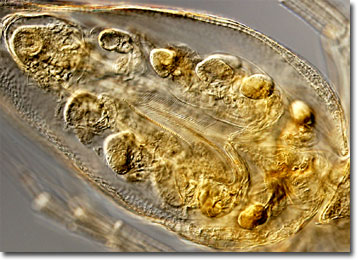Differential Interference Contrast Image Gallery
Water Flea (Daphnia)
Several types of microscopic crustaceans are commonly referred to as water fleas, but the best known are those belonging to the genus Daphnia. Most species of the prolific cladocerans flourish in freshwater environments, but a few inhabit marine locales.

Generally, Daphnia are filter feeders that consume microscopic particles from surrounding water, though a few species are predatory. The small creatures are a significant and ubiquitous link in the food chain, serving as fare for many larger animals, including several important commercial varieties of fish. Populations of Daphnia are produced parthenogenetically most of the year, but in stressed conditions they may also reproduce sexually. The fertilized eggs that result are resilient and can overwinter, withstanding freezing or drying conditions until better circumstances indicate that it is time to hatch.
Daphnia are very sensitive to their surroundings and have the ability to react to environmental factors. For instance, the water fleas develop a protective helmet-like structure around their heads in reaction to kairomones, chemicals released into the water by predators. Moreover, some types of Daphnia can adopt dwarf forms that are small enough to pass through the gill rakers of certain fish. Scientists believe that the organisms are signaled to assume this form based upon the levels of waste materials excreted by the predators into the aquatic environment.
